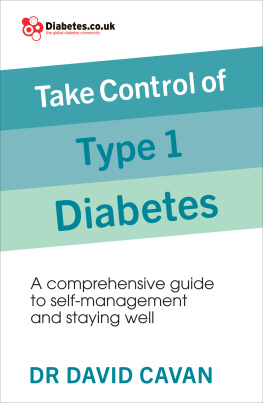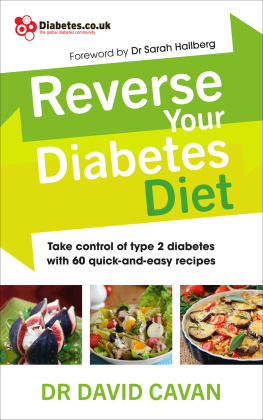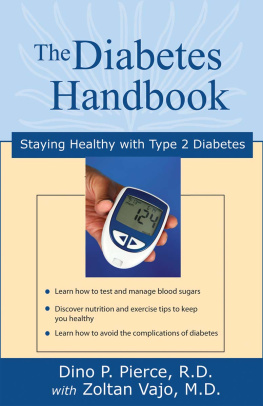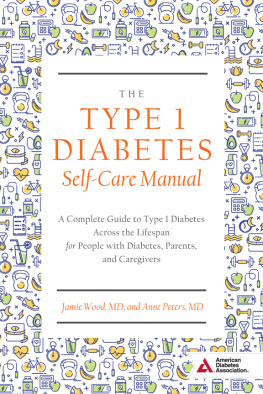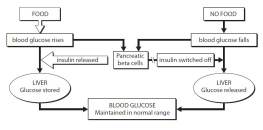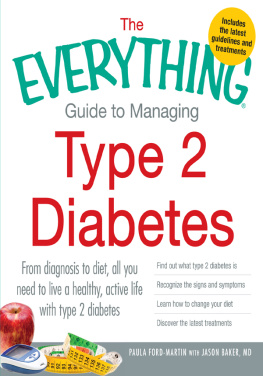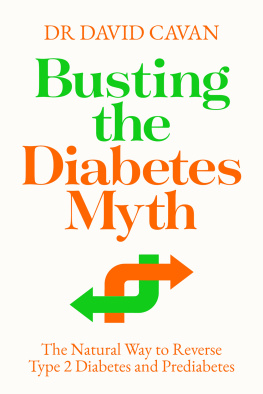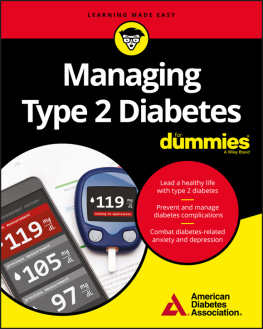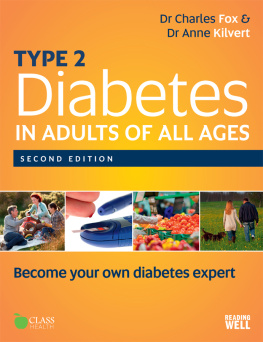CONTENTS
ABOUT THE BOOK
Around 500,000 people in the UK have type 1 diabetes about 10% of the total with diabetes. It can develop at any age, but often in previously very healthy children and young adults. This is the first book in many years that has been published in the UK to support people with type 1 diabetes in managing their condition.
Drawing on his many years working at one of the leading diabetes centres in the UK, Dr David Cavan provides a practical guide to managing all aspects of the condition, including insulin pump therapy and the latest technology available. This cutting-edge book presents invaluable advice that will offer genuine hope to adults with type 1 diabetes and their families.
ABOUT THE AUTHOR
Dr David Cavan is one of the UKs leading experts on diabetes self-management. He worked for 17 years as a consultant at the highly-regarded Bournemouth Diabetes and Endocrine Centre and in 2013 moved to Brussels where he worked for three years as the Director of Policy for the International Diabetes Federation. He now lives in the UK, working as an independent consultant supporting the development of diabetes services in the UK and overseas.
Diabetes.co.uk is the worlds largest and fastest-growing community website and forum for people with diabetes. With over 2.2m unique visitors per month and a diabetes support community of over 180,000 members sharing a cumulative 1.5m years of experience, this award-winning website has proven to positively influence health outcomes. Get support at www.diabetes.co.uk/forum
FOREWORD

I have worked as a diabetes specialist for over twenty years. Very early on, I came to realise that the vast majority of diabetes management is done by the person with diabetes, and therefore it is essential that everyone with diabetes is given the appropriate training and education that will enable them to manage their diabetes as well as possible. From 1996 until 2013, I worked as a consultant at the Bournemouth Diabetes and Endocrine Centre. During that time I developed my interest in patient education, and in order to ensure people with type 1 diabetes had the appropriate skills to manage their diabetes effectively, in 1999 we launched a self-management programme for people with type 1 diabetes called BERTIE. BERTIE was quickly adopted by many other diabetes centres around the UK and many thousands of people with type 1 diabetes have attended courses based on BERTIE over the past fifteen years. However, aware that many people still did not have access to high quality self-management education, in 2005 we developed an online resource to teach the basics of carbohydrate counting and insulin dose adjustment. This has recently been updated and is available at www.bertieonline.org.uk.
There is a limit to the amount of information that can be provided in an education programme, whether face to face or online and so I have written this book with the aim of providing a readily accessible and understandable resource that explains all aspects of the management of type 1 diabetes. My aim is that this book should provide very practical support to self-management. While the book is written for adults with type 1 diabetes, many aspects will be relevant to older teenagers. I am not a childrens diabetes specialist and the book does not cover the management of type 1 diabetes in younger teenagers or children. While some parts of the book may be of interest to the parents of children with type 1 diabetes, I would recommend the following books that specifically address the needs of children and their parents:
 Type 1 Diabetes in children, Adolescents and Young Adults, by Dr Ragnar Hanas, a paediatric diabetes specialist from Sweden provides a huge amount of information relevant for the parents of a small baby with type 1 diabetes, right through to the needs of young adults.
Type 1 Diabetes in children, Adolescents and Young Adults, by Dr Ragnar Hanas, a paediatric diabetes specialist from Sweden provides a huge amount of information relevant for the parents of a small baby with type 1 diabetes, right through to the needs of young adults. Help, My Child has Type 1 Diabetes, by Roxana Reynolds, who herself has type 1 diabetes, provides advice, information and real stories for parents and carers of a child with type 1 diabetes.
Help, My Child has Type 1 Diabetes, by Roxana Reynolds, who herself has type 1 diabetes, provides advice, information and real stories for parents and carers of a child with type 1 diabetes.
Take Control of Type 1 Diabetes has been written to support people who have just been diagnosed with type 1 diabetes, right through to those that have had the condition for many years. Although there has been a big expansion in availability of patient education in the past fifteen years, it is sadly the case that many people diagnosed before 2000, in the UK at least, received very little education on how to manage their type 1 diabetes. Very often, those who did receive education did so by attending a single course, perhaps many years ago. It is my hope that this book can help all people with type 1 diabetes fill the gaps in their knowledge about the modern management of type 1 diabetes.
The management of type 1 diabetes is entering a very exciting phase, with new insulins and technologies becoming available that have the potential to revolutionise the management of type 1 diabetes. Thus I have aimed to cover the latest developments in insulin pump therapy, continuous glucose monitoring and new insulins that provide great hope for the future. Even with these advances, it is still the case that the person with type 1 diabetes will need to take into account the impact of their lifestyle, physical activity and their food choices on their blood glucose control, and so the book provides extensive details about these aspects.
Since the early years of this century, the focus of much teaching has been to encourage people with type 1 diabetes to eat what they like, in the belief that the modern insulins now available would be able to cope with all types of diet. My experience in the years since then, has led me to the firm belief that this is not always true. Not even the best available insulins and technologies can manage meals with very high sugar or starch content and keep blood glucose within the normal range at all times. In the past several years, therefore, I have encouraged patients with type 1 diabetes to restrict their carbohydrate intake as an important means of achieving good control of their glucose levels, and the rationale for this is discussed in the book.
The book has been written primarily for a UK audience; however in order to make it relevant to readers elsewhere, the book includes sections for those for whom the insulins commonly in use in the UK are either not available or affordable. Blood glucose measurements are provided in mmol/l (as used in the UK) as well as in mg/dl (as used in US and many other countries).

